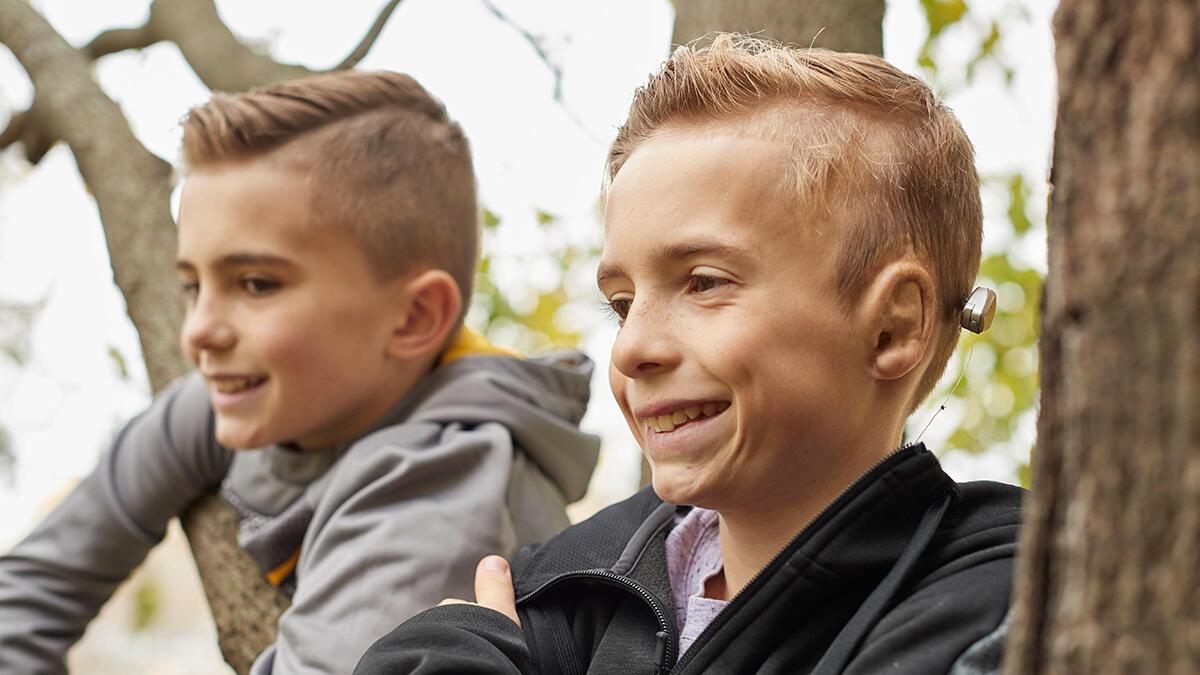Bone conduction solutions
If you or your child have conductive hearing loss, mixed hearing loss or are deaf in one ear, also known as single-sided deafness, a bone conduction solution may be able to help.

What you'll find on this page
- How bone conduction solutions work
- Bone conduction solution costs
- Types of hearing loss and introductions to the Osia® 2 and Baha® 6 Max Sound Processors
What are bone conduction solutions and how do they work?
Most people hear in two ways: by air conduction (sound traveling through the air into the ear canal) and bone conduction (sound passing through the bones in the head). Both ways of hearing help to gather sound from the environment and send it onto the brain where is it is interpreted.
If you or your child has a damaged or missing part of the outer ear or middle ear, it can sometimes be difficult for sound to reach the inner ear which then sends sound to the brain. A bone conduction solution works by bypassing the parts of the ear that aren't working.
Our bone conductions systems (Osia 2 and Baha 6) have external sound processors and internal implants. We offer both surgical and non-surgical solutions that are designed to provide unparalleled hearing performance.
Could a bone conduction solution help you?
- Can you only hear from one ear?
- Do you suffer from sore or irritated ears due to your hearing aids?
- Do you suffer from chronic ear infections?
- Do you have draining ears?
- Do you have malformed ears or ear canals?
If you answered "yes" to any of these questions, a bone conduction solution may help you to hear sounds from all sides and hear better (even in noisy situations).
Try before you buy
Try it first, then decide. With a bone conduction solution, you have the unique advantage of trying it first. Visit a Hearing Implant Specialist to try a solution before you make any decisions.
Types of hearing loss |
|
|---|---|
Single sided deafnessWhen there is little to no hearing in one ear, but normal hearing in the other ear, it is called single-sided deafness. |
Possible causes:Sudden deafness, acoustic neuroma, birth defects, genetics, head trauma, meniere's disease, malformation at birth or missing inner ear or cochlea. |
Conductive hearing lossSound cannot travel through the outer or middle ear because of chronic ear infections, draining ears or other factors. |
Possible causes:Microtia and/or Atresia, draining ears, chronic ear infections, previous ear surgeries, chronic mastoiditis or middle ear infections, skin growth or cyst (cholesteatoma), syndromes such as Down, Goldenhar and Treacher Collins. |
Mixed hearing lossRefers to a combination of conductive and sensorineural hearing loss. This means there may be damage in both the outer or middle ear and the inner ear. |
Possible causes:Any of the causes of conductive hearing loss plus any of the following: Aging, exposure to loud noise, headtrauma, genetics, meniere's disease. |
How much does a bone conduction solution cost?
Unlike hearing aids, Cochlear Bone Conduction Solutions are covered by Medicare.† They are also covered by most insurance plans* and typically Medicaid.** Contact your insurance company or local Hearing Implant Specialist to determine coverage as well as your estimated out-of-pocket expenses. The cost of the bone conduction implant will vary from person to person based on their specific health plan.
Disclaimer
Please seek advice from your health professional about treatments for hearing loss. Outcomes may vary, and your health professional will advise you about the factors which could affect your outcome. Always read the instructions for use. Not all products are available in all countries. Please contact your local Cochlear representative for product information.
Views expressed are those of the individual. Consult your health professional to determine if you are a candidate for Cochlear technology.
For a full list of Cochlear’s trademarks, please visit our Terms of Use page.
In the United States and Canada, the placement of a bone-anchored implant is contraindicated in children below the age of 5. In the United States and Canada, the Osia System is cleared for children ages five and older.
†May be covered for patients that meet Medicare's current coverage criteria.
*Contact your insurance company or local Hearing Implant Specialist to determine your eligibility for coverage.
**Coverage for adult Medicaid recipients varies according to state-specific guidelines.







